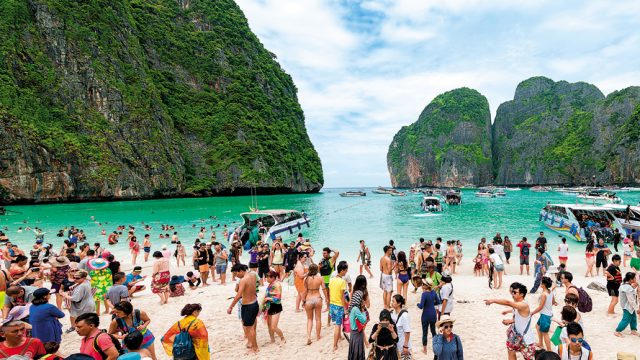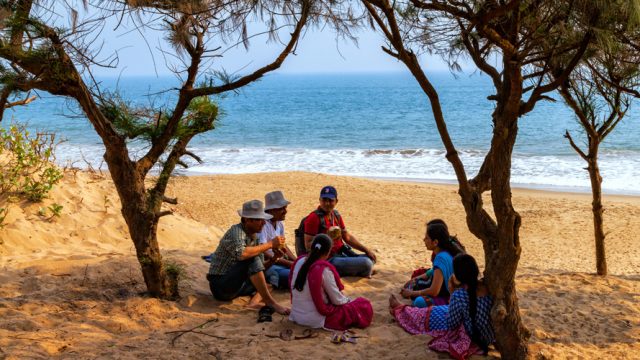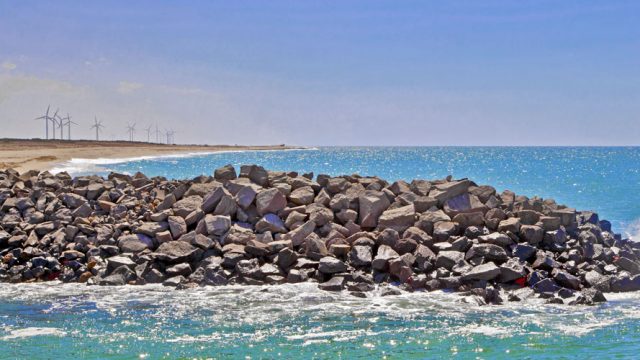Manila is not the most prepossessing of tourist destinations—on the face of it. The city is a
On a previous trip to Manila, I experienced the city’s vibrant contemporary art scene and live music, partied at its many karaoke dives and speakeasies and indulged in the favourite Pinoy pastime—shopping. So, when I revisited the city recently, I figured I was duty-bound to delve deeper into its history.

American and Japanese bombs flattened most of Manila’s prewar neighbourhoods and Spanish colonial buildings during World War II. Only Intramuros, Manila’s oldest district, by and large withstood wars, fires and natural disasters. The Spanish built the 64-hectare walled city in 1571. A stroll through the leafy cobblestone boulevards is a lesson in the city’s history.

My first stop inside the walled city was Fort Santiago. Once a seat of Spanish colonial power, today the fort is a memorial to Dr Jose Rizal, the father of Philippines’ independence from Spain. He was imprisoned in the fort before his execution in 1896. It was sobering to walk along brass footprints in the pavement that mark Rizal’s final steps to the firing squad.
The beautifully maintained gardens and plaza of the fort are at odds with centuries of horror. “During the brief period that the Japanese occupied Manila, thousands died in the prisons here. There were only two options for getting out of these prisons—either you died of disease and starvation or you drowned to death,” my guide for the afternoon, Boyet Sayo, said, pointing at the dungeons under the fort that Japanese jailers would flood with waters from the Pasig river.
A short horse-drawn kalesa ride away are two Spanish churches that survived the depredations of time. The Manila Cathedral is the eighth avatar of Manila’s first cathedral that was first built with bamboo and palm leaves in 1581. Destroyed variously by typhoons, fires, bombings and earthquakes over the centuries, its present Romanesque façade was built in the 1950s. Just around the corner from the Cathedral is the San Agustin Church.

The baroque building is the only one in Intramuros to have survived the Battle of Manila at the end of World War II. Inside is a beautiful collection of centuries-old hand-carved wooden saints.
I love big cities and big city Manila most certainly is. It’s a frantic metropolis where the native Filipino heritage is mixed with substantial dollops of American, Chinese and Spanish cultures. Like many capital cities, Manila bears little resemblance to the rest of the country. In the interests of furthering my understanding of the country, I took a flight south of the city to experience three different Pinoy destinations, each offering something different.
“It smells like hell but tastes like heaven,” is how my guide Sherwin described durian, Southeast Asia’s favourite fruit. He quickly recommended that I don plastic gloves before I ate a piece of the thick, custardy, off-white flesh of the fruit. Apparently, all the perfumes of Arabia couldn’t make my hand smell better if I touched durian without gloves.

Singapore might have a durian-shaped building but few places in the world love the stinky fruit as much as Davao. Now that I’ve tasted the ‘King of Fruits’, I am happy to have ticked it off my list and hope that I never have to do so again. Much like the other Pinoy favourite, balut—the 17-day-old duck embryo that is boiled, served with rock salt or spicy vinegar and eaten often with beer.
But Pinoy cuisine is more than just potent smells and flavours. It might not be as famous as its Thai or Vietnamese neighbours but the Philippines is home to one of Asia’s most inimitable cuisines. Another true melting pot, Filipino food takes elements of Chinese and Malaysian cuisines and mixes in massive dollops of Spanish flavours.
An excellent place in Davao to get a taste of what the locals eat is Thrunks Place, a basic roadside stall. It also happens to be a favourite of the current president of the Philippines, Rodrigo Duterte. “He comes here on weekends when he is in town,” said the owner, Ermelita Garcia Castanieto, while dishing out portions of the president’s favourite foods—pork rib soup with taro, pinakbet (mixed vegetables in fish or shrimp sauce), pancit (noodles), gizzard and pork adobo and mongo with pata (mung beans with pork leg). “This tastes like home food,” Sherwin declared to a beaming Ermelita.

The Pinoy love their meats and vegetarians will be hard-pressed to find dishes without meat or fish in some form. But if you eat pork, the Philippines is an excellent place be. Adobo (tender pork belly braised in vinegar, soy sauce, garlic and oil), lechon (whole pig stuffed with herbs and vegetables and roasted), sizzling pork sisig (tiny pieces of pig’s head and gizzards boiled, then grilled or barbecued) or chicharon (deep fried pork skin) all go down well with bottles of chilled San Miguel, the country’s favourite beer. It is entirely possible that I ate a whole pig by myself during my seven days in the country.

Endless powdery-white beaches, happiest happy hours, hotels to suit all budgets and every imaginable water sport—Boracay is a party island. In just a few years, the island has made a giant leap from low-key tropical paradise to Southeast Asia’s newest hotspot. It’s now a fixture on numerous ‘Best Beaches in the World’ lists.
The four-kilometre stretch of White Beach is the island’s most popular tourist haunt. White Beach is home to beachfront resorts, spas and bars and is the perfect spot to enjoy Boracay’s spectacular sunsets. During the day, the beach is welcoming to everyone from beach bums to adventurers. But a trip to Boracay would be wasted without partaking in any water activities. From jet skis to helmet diving, and the more laidback sundowner cruise in a traditional paraw—if a watersport exists, chances are you’ll find it in Boracay.
For me, a perfect day in Boracay started with aquatic adventures and ended at a bar. During the first half of my day on the island, I soared over the high-definition azure hanging off a parasail, ploughed through the surf on a speedboat and watched shoals of multicoloured fish through the porthole of a yellow submarine. Back on land, I headed straight to the spa at The Lind for hilot, the traditional Pinoy massage. After a long and much-needed R&R session, I stepped back on the beach just as the sun started its daily descent.

As the cabanas and white deck chairs are thrust into a rose-tinted world, the beach comes alive with candle-lit sand castles, cosy restaurants and lively bars. What’s under the water around Boracay is matched by what its nightlife offers. Bars open until dawn, fire-eating shows, karaoke singalongs and dancing chefs—Boracay has it all and then some!
The southern island of Mindanao is home to the largest number of indigenous ethnic groups in the Philippines. Commonly known as lumad (native), tribes such as the Sama, Subanen, Tenduray and T’Boli are distributed all over the island. The university town of Cagayan de Oro (oro refers to the gold the Spanish discovered in the river here) is a great place to understand the people and culture of not just the island of Mindanao but of the whole country.

Museo de Oro, at Xavier University, is the first folklore museum in the country. The museum marks the cultural evolution of the region over centuries. Exhibits range from prehistoric fossils, folklores of the various tribes, stories of colonisation by the Spanish and the Americans to bottles of Pepsi and even a BlackBerry phone from the post-colonial period. The third, and comparatively newer and smaller section, houses memorabilia donated by the museum’s founder, Fr. Francisco R Demetrio SJ.
Look out for the rare copy of the menu from the dinner hosted by the Philippines’ first president Emilio Aguinaldo on September 29, 1898 to mark the ratification of the Declaration of Independence.
After spending a few hours at the museum, I headed out of Cagayan de Oro to the Malasag Eco-Tourism Village. A living museum of sorts, Malasag is also a venue to showcase dances and craft of various tribes that live there. I was welcomed by troupes of dancers from different tribes before being quickly ushered into their makeshift craft shop to buy beaded jewellery and capuchin skull decorated with coloured glass. It did feel like a Disneyfied introduction to these ethnic tribes but Malasag is worth a visit, if for nothing else then the spectacular views of the city and the Macajalar Bay.
The Information
Getting There
There are no direct flights to destinations in the Philippines from India. Several airlines connect Manila with Indian cities, via Southeast Asian destinations such as Hong Kong, Singapore or Kuala Lumpur. Fares for a return economy ticket from Delhi and Mumbai start from approx. ₹30,000.
Getting Around
Several budget airlines fly between major destinations around the country. But most routes go via Manila or Cebu.
Visas
Indians with valid Australia, Japan, Canada, Singapore, Schengen, US or UK visas are eligible to enter the Philippines without a visa for 14 days. If you don’t have any of these visas, apply to the Philippines Embassy or any of its consulates in Mumbai, Kolkata or Chennai. A single-entry visa costs ₹2,840.
Currency
1 Philippines peso = approx. ₹1.35. US dollars are the most widely
accepted foreign currency.
Where to Stay
Like most destinations in the archipelago, Davao, Boracay and Cagayan de Oro offer multiple options at different prices. A short ferry ride from Davao City is the uberluxe Pearl Farm Beach Resort (₹14,000, pearlfarmresort.com). Surrounded by pristine private beaches, Pearl Farm is the picture-perfect tropical getaway. In Boracay, budget dictates where you stay. Accommodation on White Beach is divided into Station 1 (high-end), 2 (mid-level) and 3 (budget). One of the newer hotels on the strip, The Lind (₹27,000; thelindhotels.com) on Station 1 is a great option to enjoy Boracay’s legendary sunsets and powdery white sand. With tourists beginning to discover Cagayan de Oro and the Northern Mindanao region, hotels in the city are booming. The Limketkai Luxe
Hotel (₹5,000; limketkailuxe.com) located midtown is a great
mid-budget option.
What to See & Do
> DAVAO
One of the largest commercial hubs in the country, Davao is bookended by the majestic Mount Apo and the ultramarine Philippine Sea. There are numerous snorkelling and dive sites in the area. Animal lovers will enjoy the Crocodile Farm, the Monfort Bat Cave Sanctuary and the Philippine Eagle Center, which is the home of the monkey-eating national bird of the country.
> BORACAY
It is entirely possible to spend all your time in Boracay sprawled on the white sand but many would think it a waste to not sign up for any or all of the watersports available. On offer are jet skiing, kayaking, skimboarding, windsurfing, parasailing, diving, island hopping, helmet-walks and submarine rides. And, after a day of heart-thumping action, you can party anywhere on Station 2, Boracay style!
> CAGAYAN DE ORO
Known as the Gateway of Northern Mindanao, Cagayan de Oro is making a name as a must-do for adrenaline junkies. The city is the perfect base for outdoor adventures like whitewater rafting, horse riding, rappelling, hiking, rock climbing, caving and zip lining. More sedate activities can be had at the all-weather, 18-hole golf course at Pueblo de Oro Golf.
What to Buy
If you are looking for something cheaper, Boracay’s D-Mall is lined with stalls selling shell jewellery. Also look out for Barong Tagalog—the formal embroidered Philippine shirt for men. Jeepneys are an integral part of any Filipino holiday, so do bring back a toy version.
durian
Filipino cuisine
Fort Santiago





